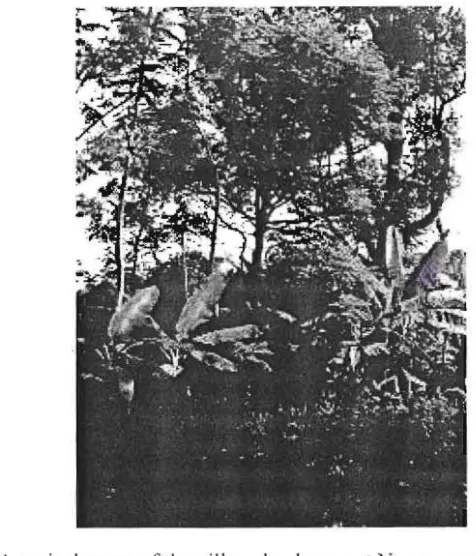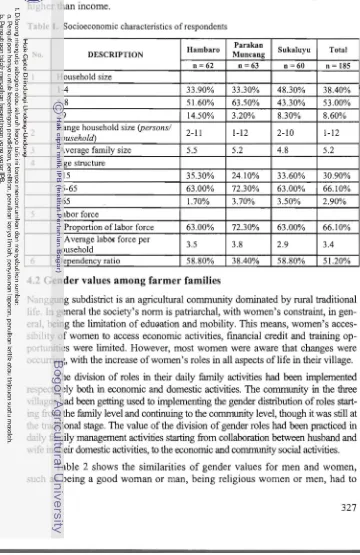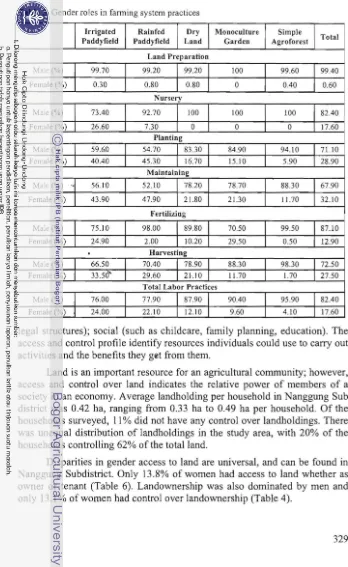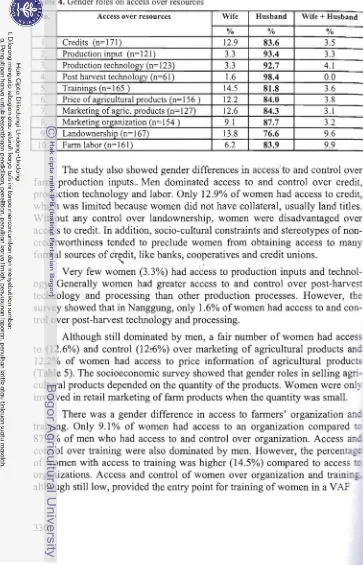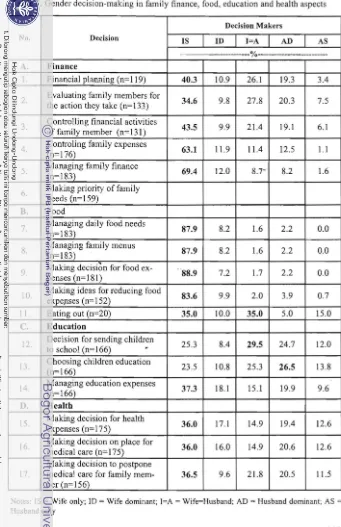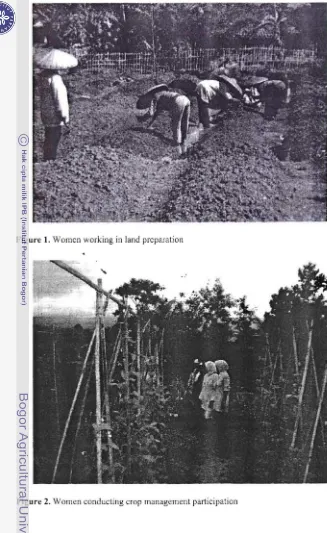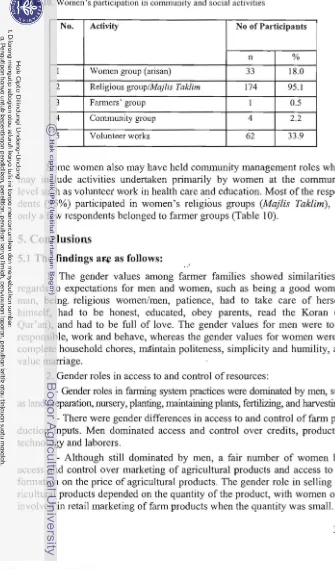·USAII
fROM THE AMERICAN FEEditeH, Anas D. Susila, Bambang S. Purwoko, James M. Roshetko, Manuel C. Palada, Juang G. Kartika, Lia Dahlia, Kusuma Wijaya, Artf Rahmanulloh, Mahmud
Raimadoya, Tri Koesoemaningtyas, Herien Puspitawati, Tisna Prasetyo, Suseno Budidarsono, Iwan Kurniawan, Manuel Reyes, Wamaya Suthumchai, Karika Kunta
'W J' \I
'it}",?
r
II
\Il! " / 511/ !f "
\ 1''If!'1'
r,?'T'!t'JII'
'IrEP I:!Z"
Special Publication No. 6c
litars: Anas D. Susila, Bambang
s.
Purwoko, James M. Roshetko, Manuel C. Ida, Juang G. Kartika, Lia Dahlia, Kusuma Wijaya, Alii Rahmanulloh, Mahmud timadoya, Tri Koesoemaningtyas, Herien Puspitawati, Tisna Prasetyo, Suseno idarsono, Iwan Kurniawan, Manuel Reyes, Wanraya Suthumchai, Karika KuntaPronunciation: IJ-' ky{uuml} 1 Funct ion: n
De finition: [ i-intelligent q - flow I
1I : term used to express the superior ゥョエ・ャャゥァ・ッ セ\L@ 2co ustic Doppler measurement device; b: a score on a standardized intelligence test d.:term ined by extraordinary data collection capabilities relative to the average performance . a ther flow meters.
flow-control
TOTAL VOLU ME
.
Designed
forTurnout
pie installation
Irrigation
Save
water. Save money.
_BBL セ エゥッョウ@ at '[ In!l·Y-_(O!}lllq.
M ᄋ セ NXSRW@
. LNGセ ..
Map of Southeast Asia from www.leamnc.org/lp/multimedia/3 J90 LEARN NC is a program of the
University of North Carolina at Chapel Hill School of Education We are grateful to the map producer for making it available widely.
THE UNIVERSITY
oj NORTH CAROLINA
A typical scene of the village landscape at Nanggung Subdistrict
of Bogor District
in
West Java Province of Indonesia where there-search team studied to find ways to alleviate poverty and reduce food scarcity and environmental degradation in Southeast Asia by combining economically viable and resource-conserving technolo-gies with gender-friendly socioeconomic policies to integrate vege-table production in agroforests on small farms
[image:4.597.103.341.24.302.2]l
M セ G ・イ@ investigation were identified (Hambarc
:I -basin No. 24).
i.s required to provide the hydrological dat.::
or two sub-basins.
. • :ion exercise immediately, data from Bah.
- used as an interim product, to check the reo . indonesia.
;. lhe MW-SWAT application received c . :0 include the Citarum and Cimanuk water·
: .- (rice) investigation.
; .e through support proVided by the United
)e elo pment and the generous support of the
-e Sustainable Agriculture and Natural Re-. _ Research Support Program (SANREM . .. e Agreement Award No.
EPP-A-OO-04-na l Research and Development (OIRED) -..: .ate University (Virginia Tech).
- , 11 aod J.G. Arnold. 2007. The Soil and Water
セ ⦅@ セAHj ーュ・ ョエ L@ Applications, and Future Researct
セ@
- •. .1
セ@
.,
.:"':'"Base: SWAT in an open source GIS . Th e Open
·ng and Graphing Tools (SWATPlot and (access date Jan. 2009).
Observation Research Centre (EORC), Japan
or SWAT (MWSWAT). WWW.waterbase.or£
sing and Set-Up of the Required Watershec S WAT). www.waterbase.org (access date Jao.
Trisasongko and Nurwadjedi. 2008. ALOS· (AIPEX): First Result. European Space
d J.R. Williams. 2006. A modelling approach to a lity management plans implemented in 2 Modellng & Software. 21 (2006): 1141-1157.
Part 5
22. Gender Roles of Farmer Families in
Vegetable-Agroforestry System: A Case Study at Nanggung
Subdistrict, Bogor, West Java, Indonesia
Tri Koesoemaningtyas
I,Herien Puspitawati
2and Tin Herawati
3Abstract
The objectives of the study were to examine women's involvement in decision making to ensure their participation in Vegetable Agroforestry (V AF) production and marketing training, and to increase the involvement of women farmers or marketing associations. The study was done at Hambaro, Parakan Muncang and Sukaluyu Villages, Subdistrict of Nanggung, District of Nanggung, West Java Province in June-July 2006. A total of 185 household respondents were selected randomly . Results showed that men dominated gender roles in farming system practices such as land preparation, nursery, planting, maintaining plants, fertilizing and harvesting. Moreover, there were gender differences in access and control over farm production inputs. Men dominated access to and control over credit, production technology and bbor. A fair number of women had access to and control over marketing of agricultural products and had access to price information of agricultural product; Women had insignificant roles in decision making on farming, farm financial planning and activities, but were dominant as decision -makers in domestic family planning including evaluating the actions of fam -ily members, and controlling their fam-ily financial activities. Men acted as dominant decisionmakers with regard to farming financial planning, and some of domestic responsibility especially on choosing children 's education.
Keywords: Gender roles, gender values, access and control
IDepartment of Agronomy and Horticulture, Faculty of Agriculture, Bogor Agricultural University, )1.
Meranti , Komplek IPB Dannaga, Bogor 16698, Indonesia. HP: +62 8 12180 66284, dera- dyti@pacific.net.id, trikadytia@gmail.com
2Lecturer, Department of Family and Conswner Sciences, College of Human Ecology, Bogor Agricul-
tural University, )1. Meranti, Komplek IPB Dannaga, Bogor 16698, Indonesia, & National Expert
Member at Department of National Education, Republic of Indonesia. HP : +62 8 1111 0920, herienyuspitawati@email .com
3Lecturer, Department of Family and Consumer Sciences, College of Human Ecology, Bogor Agricul-
tural University, )1. Meranti, Komplek IPB Dannaga, Bogor 16698, lndonesia, & PhD Candidate in
324
1.
Introduction
1.1 Underlying background
The Vegetable Agroforestry (VAF) System developed through the sanreセ@
Project in Indonesia is expected to alleviate poverty, food scarcity and redu( environmental degradation in Indonesian watersheds . The project on veget: ble agroforestry in Indonesia was undertaken in Kecamatan Nanggung, a sut district located in the western part of West Java province.
This project recognizes the importance of women in vegetable prot:_
tion in small-scale farms. The participation of women in this project セ ]ᆳ
ever, was impeded by many constraints against women's participation an-: ':'
women's relative lack of time and mobility caused by their キッイ ォャ d セ@
multiple roles. If this project is to benefit from women's contributi 7'. 0 - '
lective views and improve the socioeconomic wellbeing of wome D セ セ@ ]ᆳ
in vegetable production and agroforestry enterprises, a range of ウ エイ。 セ MZZ@ _
practical measures must be taken to overcome these barriers.
The first step in formulating specific gender strategies is to セ@
gender analysis, which helps identify constraints and helps structure :"-.:'
tiative. The results of a gender analysis are incorporated into plannin · セ@
sure that development benefits and resources are effectively and e
セ@
.targeted to both WOlDen and men, and to successfully anticipate ane . negative impacts development may have on women or on gender relati C':...,
1.2. Objectives of the study
The objectives of the study were :
1. To describe the gender values among farmer families.
2. To examine gender roles in access and control over resources,
3. To examine gender roles in decision making in farm households
=
coping strategy, and also domestic and agricultural activities.
2. Literature Studies
Gender Mainstreaming was defined by the Unescap in 1997 as a strateg: making women's as well as men's concerns and experiences an integral =-mension of the policies and programs. The Government of Indonesia's ..: creased efforts to include Gender Mainstreaming into its national devel =:
ment process is an affirmation of the commitment to gender equality and セ@
rights of both women and men (KPP-UNDP, 2007).
-F -
ste m developed through the SANRElI.f .1 -. -iate poverty, food scarcity and reduce . ZZM・@ セゥ@ n watersheds. The project onvegeta-⦅ ZZ ZZ Z セ ZMエ。 ォ・ョ@ in Kecamatan Nanggung, a sub-est Java province.
rtance of women in vegetable produc- ation of women in this project, how- :::...::;.; against women's participation and by
: :no bility caused by their workload and
_:.e I t from women's contribution and col-
:. セ@ セ@ nomic wellbeing of women engaged
:' : M ZウZB セM enterprises, a range of strategic and . C", cfcome these barriers.
:: i ecific gender strategies is to conduct . : o nstraints and helps structure the
ini-:.. .
,,:.i
are incorporated into planning toen-.セ@ :es,o urces are effectively and equitably
.0..::.': to successfully anticipate and avoid
_:::: e on women or on gender relations.
_ __ : among farmer families.
_ ::..:: :ess and control over resources .
_. ;::tX ision making in farm households and _ :..::. ' agricultural activities.
.: :: ;. the Unescap in 1997 as a strategy for
' ; _セ Z Qc ・イョウ@ and experiences an integral
di-. ";:::-:"--::-di-.5 di-. The Government of Indonesia's
in-Z@ ZM セ@ .' :!instreaming into its national develop-. :develop-.:e co ounitrnent to gender equality and the
セZZ_ L"")fDP, 2007).
M ZNZZM セ ュゥョァ@ aims at promoting a fair distribu-:: 1:'cnefits of development processes and
population programs. As Indonesia is now implementing a decentralized de-velopment approach, the need to mainstream gender concerns in local govern-ment's programs and policies has become more important (KPPBKKBN-UNFPA,2004).
The meaning of gender is different from the meaning of the type of sex . However, both gender and the type of sex involve both men and women. The type of sex in general is applied to identify the natural difference between men and women in terms of biological anatomy. Meanwhile, gender dis-cusses the differences of role distribution and function between men and women that are decided by the corrununity and culture since they were born and this is unnatural. At this point, gender does not discuss women only, but also men in relation to cooperation and partnership, and the role distribution between men and women to achieve the same goal. Therefore, gender dis-cusses the problems of both men and women in society. Thus, gender refers to the corrununity perspectives toward roles, functions and responsibilities among men and women which are a result of social and cultural constructions that can be changed along with the dynamics of time and community aspira-tions (KPPBKKBNUNFPA, 2004).
The application of gender roles in the households is shown by the power of men and women, with women typically being the less powerful
partners. The 、ゥヲヲ・イセ」・ウ@ in power between men and women are directly
re-lated to differences in their income and 'other resources. The work of women at home is unremunerated, and therefore not regarded as 'real' work, and of-ten constrains women's opportunities to earn outside income. Thus, the public world of work is a man's domain, but the private world of home is a woman's domain (Renzetti and Curran, 1995).
Gender roles in agricultural activities are influenced by the gender di-vision of labor. In some countries women are virtually fulltime farmers, while in other countries women do little work in fields. In some places, women are active farmers and work sidebyside with the men in the fields and in other places women work separately from men in the fields (Osteergaard, 1992).
3. Research Methodology
3.1 Location of the study
326
respondents consisted of 62 fanners' families from Hambaro Village, 63 fanners' families from Parakan Muncang Village, and 60 fanners' families from Sukaluyu Village.
3.2 Types of information required and their sources
Baseline data for the socioeconomic characteristics were gathered in a survey. To provide gender-disaggregated infonnation, the wives or adult women of the households were interviewed to gather infonnation on: socio economic characteristics of the respondents, gender values among fanner families (men and women), identification of gender needs (practical and strategic needs): gender roles in fanning system practices, gender roles in control of the agricultural inputs expenditures, gender roles in access and control profiles. gender roles in decision making profile, and domestic and agricultural activity
profile. . , .
3.3 Methods of analysis
The infonnation collected will be analyzed by using the gender analysis ap-proach (using Harvard and Moser Gender Analysis Techniques). Gender analysis is a process that analyzes data and infonnation systematically abou men and キッュ・ョセエッゥ、・ョエゥヲケ@ and indicate the status, function, role and the responsibility of men",and women and the affected factors (KPPBKKBi\ -UNFPA,2004).
4. Findings
4.1 Socioeconomic characteristics of the respondents
Findings show that around 50 percent of the respondents had 5-8 famil: members, with household ウセコ・@ ranging from 1 to 12 persons and the average family size at 5 persons (Table 1). The proportion of labor force was arouni 66 percent with the average labor force per household at 3.4. The dependenc:.· ratio of the respondents was around 51 percent. About 6 percent of the re-spondents were illiterate which is lower than the national data (9.07%).
Based on the family daily expenses, the expenditures on food キ・イセ@
around Rp20 ,075. The daily expenses for rice range from Rp533 to rーVLQSセ@
and the daily average expenses for cigarette was Rp3,434 .
:- milies from Hambaro Village, 63 and Parakan Muncang the lowest (38.1 %). Based on income-expenditure
illage, and 60 farmers' families data, 15% of the surveyed households had negative income with expenditures
higher than income.
Table 1. Socioeconomic characteristics of respondents d their sources
: - :... -ot leristics were gathered in a survey.
' : .,. セ@ ゥゥ ッョL@ the wives or adult women of
セセZ }M i ・イ@ information on: socio economic
MNNZ ⦅ セ@ 'a lues among farmer families (men __ ZZ ・セ 、ウ@ (practical and strategic needs) ,
. _. Mセ N[[@ oender roles in control of the
セMセ Z@
-:;iet
in access and control profiles, d domestic and agricultural activityセセ ZZ セ ・イ@ Analysis Techniques).
セ@ .=.:: '
_ : _ .
:: :.-.e affected factors
..,: .)f th e
.. ".
_--" :-:0 ortion of labor force was around
⦅ セ@
- : :" rece nt.
:: i-31l
the national data (9.07%)., _ZMMセ@ ・ウN@ the expenditures
セ@ Z セ
I e.
_::d by using the gender analysis ap-Gender i.nformation systematically about e status, function, role and there-
(KPP-BKKBN-respondents had 5-8 family
1 to 12 persons and the average
;-:- household at 3.4. The dependency About 6 percent of the
re-on food were
Z@ rice range from Rp533 to Rp6,135
=..:...-e:-:e was Rp3,434.
:. :.:.> mct were engaged in agriculture -: -⦅ セ GM オ エ ・、@ the most to the total household
.;..:: Rp l,226,OOO/month or Rp236,0001
_ ;f': showed that 52% of the surveyed
:..: -: セ | M ・イエケ@ line (income lower than
:-:... . ,-,ith the higher proportion (67.7%)
No. DESCRIPTION Hambaro
Parakao
Muncang Sukaluyu Total
n =62 0=63 0-60 n = 185
1 Household size
1-4 33.90% 33.30% 48.30% 38.40%
5-8 51.60% 63.50% 43.30% 53 .00%
>9 14.50% 3.20% 8.30% 8.60%
2 Range household size (persons/
household) 2-11 1-12 2-10 1-12
3 A verage family size 5.5 5.2 4.8 5.2
4 Age structure
< 15 35.30% 24.10% 33 .60% 30.90%
\5-65 63.00% 72.30% 63 .00% 66.10%
>65 1.70% 3.70% 3.50% 2.90%
5 Labor force
- Proportion of labor force 63.00% 72.30% 63 .00% 66.10%
- Average labOt: force per
household 3-.5 3.8 2.9 3.4
6 dセ・ョ、・ョ」ケG ratio 58.80% 38.40% 58.80% 5\.20%
4.2 Gender values among farmer families
Nanggung subdistrict is an agricultural community dominated by rural traditional
life. In general the society's norm is patriarchal, with women's constraint, in
gen-eral, being the limitation of eduGation and mobility. This means, women's acces-sibility of women to access economic activities, fmancial credit and training op-portunities were limited. However, most women were aware that changes were occurring, with the increase of women's roles in all aspects oflife in their village.
The division of roles in their daily family activities had been implemented
respectively both in economic and domestic activities. The community in the three
villages had been getting used
to
implementing the gender distribution of rolesstart-ing from the family level and continustart-ing to the community level, though it was still at
the traditional stage. The value of the division of gender roles had been practiced in
daily family management activities starting from collaboration between husband and
wife in their domestic activities,
to
the economic and community social activities .Table 2 shows the similarities of gender values for men and women, such as being a good woman or man, being religious women or men, had to
[image:10.595.22.382.53.608.2]be patient, had to take care of herself/himself, had to be honest, educa セ@
obey parents, reading Koran (AI Qur'an) and had to be full of love. T
gender values for men were to be responsible, responsible, hard working. ::: to behave, whereas the gender values for women included being ab le
perform their household chores, politeness, simplicity and humility, and to セ@
married quickly.
Table 3 shows the gender roles in farming system practices which Te··
·-that males dominated the implementation of all farming system activities, sue. land preparation, nursery, planting, maintaining plants, fertilizing and harvesti=
Table 2. Gender values for women and men
Values Women Men
No.
n % . n
-I.
I Obeying husband 67 36.6
-
-2 Has to be responsible - - 31 16 ..
3 Being a good woman/man 22 12.0 9 T N セ@
4 Has to work -
-
7440.-5 Being religiou s women/men 17 9.3 13 7.1
6 Doing household chores 27 14.8
-
-7 Reading Koran (AI Qur'an) 12 6.6 -
-8 Has to be patience II 6.0 4 2 :
9 Has to take care of hersel£'himself 9 4.9 7 :l.S
10 Has to be honest 3 1.6 8 ;1 .':
' .
II Has to be educated 2 1.1 8 M エ セ@
12 Has to be polite 2 1.1 -
-13 Has to obey ー。イセョエウ@ 4 2.2 5
_.
-14 Has to be full of love 2 1.1 12 6.:
15 Being simple and humble 3 1.6 -
-16 Has to married soon 2 1.1
-17 Behave - - 12 V ⦅@ セ@
4.3 Gender roles in
access
and control profilesProductive, reproductive and community roles of women require the LO .
resources. In general, women and men had different levels of both acee,;
control over resources. Access is the opportunity to make use of the re o\. _ . needed for their work, and control is the ability to define its use and ' _ that definition on others over those resources. Resources can be ee o;: : (such as land or equipment); political (such as representation, leadersh ip ::.;
Table 3. Gender roles in fanning system practices
セ@ "" hi mse lf, had セッ@ be honest, educated.,
⦅ セ M 。 ョ@ and had to be full of love. The __ <; ible, responsible, hard working, and
M セ NZN@ lor women included being able to
MM [セUsL@ simplicity and humility, and to get
.;. --. funning system practices which reveal
- :1 of aU farming system activities, such as
,::,-=·..aining plants, fertilizing and harvesting.
Women Men
n % . n %
67 36.6
-
-- - 31 16.9
22 12.0 9 4.9
-
-
74 40.417 9.3 13 7.1
27 14.8
-
-12 6.6 -
-11 6.0 4 2.2
セ@ 9 4.9 7 3.8
3 1.6 8 4.4
2 J.1 8 4.4
2 1.1 -
-4 2.2 5 2.7
2 J.1 12 6.6
3 1.6 -
-2 1.1 -
-- - 12 6.6
I
profiles
セ@ -y roles of women require the use of
_ セMM "'ad different levels of both access and
M セ M セ GZZ@ nrtunity to make use of the resources
セ@ セ セ ・@ ability to define its use and impose _ セ・UP オイ」・ウN@ Resources can be econorru
_.:. セ@ h as representation, leadership and
Irrigated Rainfed Dry Monoculture
I
SimpleI
Total Paddyfield Paddyfield Land Garden AgroforestLand Preparation
Male (%) 99.70 99.20 99.20 100
1
99.60J
99.40Female (%) 0.30 0.80 0.80 0
I
0.40I
0.60Nursery
Male (%) 73.40 92.70 100 100
1
100I
82.40Female (%) 26.60 7.30 0 0
I
0J
17.60Planting
Male (%) 59.60 54.70 83.30 84.90
l
94.10I
71.10Female (%) 40.40 45.30 16.70 15.10
1
5.90J
28.90Maintaining
Male (%) . 56.10 52.10 78.20 78.70
r
88.30I
67.90Female (%) 43.90 47 .90 21.80 21.30
I
11.70J
32.10Fertilizing
Male (%) 75.1 0 98.00 89.80 70.50
I
99.50I
87.10Female (%) 24.90 2.00 10.20 29.50
1
0.50J
12.90.
HarvestingMale (%) 66.50 70.40 78.90 88.30
I
98.30I
72.50Female (%) 33.50'" 29.60 21'.10 11.70
I
1.70I
27.50 Total Labor PracticesMale (%) 76.00 77.90 87.90 90.40
1
95.90I
82.40Female (%)
I
24.00 22.10 12.10 9.60I
4.10I
17.60legal structures); social (such as childcare, family planning, education). The access and control profile identify resources individuals could use to carry out activities and the benefits they get from them .
Land is an important resource for an agricultural community; however, access and control over land indicates the relative power of members of a society in an economy. Average landholding per household in Nanggung Sub district was 0.42 ha, ranging from 0.33 ha to 0.49 ha per household. Of the
households surveyed, 11 % did not have any control over landholdings. There
was unequal distribution of landholdings in the study area, with 20% of the households controlling 62% of the total land.
Disparities in gender access to land are universal, and can be found in Nanggung Subdistrict. Only 13 .8% of women had access to land whether as owner or tenant (Table 6). Landownership was also dominated by men and
only 13.1 % of women had control over landownership (Table 4).
[image:12.595.23.371.21.588.2]330
Table 4. Gender roles on access over resources
No. Access over resources Wife Husband Wife + Husband
% % 0/0
I. Credits (n= 171) 12.9 83.6 3.5
2. Production input (n= 121) 3.3 93.4 3.3
3. Production technology (n=123) 3.3 92.7 4.1
4. Post harvest technology (n=61) 1.6 98.4 0.0
5. Trainings (n= 165 ) 14.5 81.8 3.6
6 Price of agricultural products (n= 156 ) 12.2 84.0 3.8
7. Marketin& of agric. products (n= 127) 12.6 84.3 3. 1
8. Marketing organization (n= 154 ) 9.1 87.7 3.2
9. Landownership (n= 167) 13.8 76.6 9.6
10. Farm labor (n=161) 6.2 83.9 9.9
The study also showed gender differences in access·tb and control over fann production inputs .. Men dominated access to and control over credit, production technology and labor. Only 12.9% of women had access to credit, which was limited because women did not have collateral, usually land titles. Without any control over landownership, women were disadvantaged over access to credit. In addition, socio-cultural constraints and stereotypes of non-creditworthiness tended to preclude women from obtaining access to many fonnal sources of c'redit, like banks, cooperatives and credit unions.
'"
.'Very few women (3.3%) had access to production inputs and technol-ogy. Generally women had greater access to and control over post-harvesi technology and processing than other production processes. However, the survey showed that in Nanggung, only 1.6% of women had access to and con-trol over post-harvest technology and processing.
Although still dominated by men, a fair number of women had access to (12.6%) and control (12:6%) over marketing of agricultural products ane 12.2% of women had access to price infonnation of agricultural ーイッ、オ」 セ@
(Table 5). The socioeconomic survey showed that gender roles in selling agri-cultural products depended on the quantity of the products. Women were 0 :
involved in retail marketing of fann products when the quantity was small. There was a gender difference in access to fanners' organization ar.:: training. Only 9.1 % of women had access to an organization compared : : 87.7% of men who had access to and control over organization. Access ar.:' control over training were also dominated by men. However, the ー・イ」・d エ。 eセ@
[image:13.595.29.392.29.594.2]セ...::-: .:
Wife Husband Wife + Husband
% 0/0 %
[ [
12.9 83.6 3.5
3.3 93.4 3.3
3.3 92.7 4.1
[ 1.6 98.4 0.0
14.5 81.8 3.6
(1:.W'1 12 .2 84.0 3.8
N Z@ セ ェ@ 12.6 84.3 3.1
I 9.1 87.7 3.2
13.8 76.6 9.6
6.2 83.9 9.9
Table S. Gender roles on the control over and benefi t from resources
No. Control over and benefits from resources Wife Hu.<band Wife + Husband
0/0 0/0 %
I. Farming activity (n=161) 5.5 83.2 10.6
2. Production iI]Juts (n= 119) 4.2 84.9 10.9
3. Production technologyin=123) 4. 1 85.4 10.5
4 . Post harvest technolqgyin=61l 1.6 95.1 3.3
5. Trainings (n=165) 12.1 83.6 4.2
6. Agric. price information (n= 161) 11.8 80.1 7.1
7. Marketing of agric. products (n= 143 ) 12.6 80.4 7.0
8. Marketing organizationJn= 154) 4.5 83.8 11.7
9. Land ownership (n= 168
J
13 .1 78.6 8.310. Farm labors[n=168) 13.1 78.6 8.3
セ@ .:!i -erences in access to and control over
セ ZZGセ ヲG@ access to and control over credit,
. _: L .9% of women had access to credit, ::._ ::. :-. O! have collateral, usually land titles.
"__セ ー N@ women were disadvantaged over
_ :-L j constraints and stereotypes of non· ." en from obtaining access to many . ::. :-::eratives and credit unions.
• :" . :''='S 5 to production inputs and
technol-.. セ ⦅ M MN」N[[ ウ@ to and control over post-harvest . . . roduction processes. However, the
._6 ' 0 of women had access to and
con-::.
Z[Mセ イ@ セ N・ウウ ュァN@- ---.. a fair number of women had access
セ@ - .J..L-eting of agricultural products and
'e information of agricultural products
__ セMZ@ Z IiN| ..ed that gender roles in selling
agri-...2:"-:- '_ of the products. Women were only
セ ZZ@ セ@ cts when the quantity was small. : '; _-: ac cess to farmers' organization and
. , -:-ess to an organization compared to
::. :":Introl over organization. Access and
セ ᄋ Z・、@ by men. However, the percentage
セ@ :::gber (14.5%) compared to access to
_.; u.:nen over organization and training,
. : _:.. i for training of women in a V AF
system. The access and control profile showed the extent to which women
were impeded from participating equitably in the project. If women had
lim-ited access to income or land, they may be unable to join groups, which pro-vide production inputs and commercial opportunities, or to become independ-ent commercial vegetable producers.
4.4
Gender roles
indecision-making profile
Women frequently 'Perform a variety of functions in the farm household. They act as food producers, wage earners, caretakers of the family looking after nutrition, and post-harvest managers. Several studies have shown that gender affects the decision-making process in agricultural production and household expenditures, as well as the management of food consumption within the farm households (Balaguru, 1992).
The survey results showed that in the three villages of Nanggung, women had insignificant roles tn decision making regarding farming financial planning and activities (Table 6). The decision on farm financial planning and expenditures were dominated by men, including making routine farm
finan-cial planning (55 . 1 %), and planning for purchase of production inputs
(54.3%).
Women were more involved in family financial planning (31.3 %). A larger proportion of women were motivated to learn about family financial planning (40.2%) compared to the percentage of women (11.2%) who were interested in learning about farm financial planning. The decision to plan for the types of commodity to plant and the utilization of home gardens for food crops was dominated by men (34.4%) but in some households women
[image:14.595.25.381.3.608.2]Table 6. Gender decision-making in farm households
NfJ" [ッNNセ ...o" Dfc" itnl セiャiQZエャセ@
IS ID
I
I..A AD /..$- -- -.-.,- -.• A ・MセNMNM NZZM N@ ML@ M
- 1 Ro\l1io'e Wni!l tmaocul.£\jl.lIJlillZ.
Ve]
19} zセY@ , . t.Q, I セ セ@ i セ G@ ャ@ 2:172 R¢liIirle fltNJ:\ f'1lI116 tsal ph noiJIf H jIoF ャQ セ@ 102 34 21.7 WLセ@ セセ ⦅ ャ@ 3 Prli'did ioll q セ@ f.mlh tort o( lI"LlI:R (n=U1 } 31.$ 11.:1 30.5 I )' 8 22.9
·t ヲゥjャ。ャェN」ェャャ セ@pi l1lcil1g bl!fru-e p utC'wi:4r. illpll:ti
(,.s \29) , . .
93 6. 2 2(t.8 5,4
-
.セNS@
S. R.eC<l rd:mg .ellPt;I1diW(:<\ (rFSll 1:5,1 'V) 2>.5 コNセ@ セ Y@
6.
r.-"
t.o ュ セョイ ュ ヲ ュセ エセ@ {rF12Si) 11,:l 52 2Hl ).'1 セ N R@7 l.<!",,,, !!I.> oGjャ|ャI。 ァ\Zセiャy@ Z[ッ セ ・@ ('Jl'&117) セ ZQ@ 6 S セ L R@ セ N@ セ@ \ 6.'2
e
fZ'I'i セセー ャゥャ|GQオヲ セ@ aCJ;'O'rdmR II) plu r HfセセHャI@ 14.0 12 0 24..0 6.0 +;U)9. Sdfe'i'Alu.ttic.t! on fu) lIei!;! ュ ャ オャ BGX セ Gャi・Zョエ@ ⦅ セエ 32') 9$ 4.5 3U W N セ N@ .17.0
10 イャセ ャuiゥセ@ エQヲGセセ@ of t.ommo-dity (1l"l 6) セQ@ 7.11 J.1A 6. t 46..(1
11. エQャオゥャゥャエゥャゥコ[idX N@ ャャッュセ@ ・セヲᆱイi@ (Qr food (fq>1
(.:F114)
11.4 4 .4
:z&l
as
..1...i
Notes : IS = Wife only; AS = Husband only; ill = Wife dominant, AD = Husband dominant ; I=A = Wife=Husband
Table 7 shows that women were dominant as decision makers in financial planning, evaluating the actions taken by family members, controlling financial activities of family members, controlling family expenses, managing "family finances, prioritizing family needs, managing daily food needs, managing family menus, making decisions on fooc expenses, and generating ideas on reducing food expenses. They were also the decision makers on health expenses, the place for medical care or postponing medical セ。イ・@ for family members, and managing education expenses. Meanwhile, there are some responsibilities of domestic chores dis-tributed equally through men and women as decision makers, especially in child education planning alJd eating out.
Table 8 shows that the female roles in family coping strategy consiste . of adding resources from outside (through asking the wife to work or borrow-ing money), savborrow-ing resources (through decidborrow-ing on a savborrow-ings account or de-ciding on withdrawals from savings), cutting back on expenses (through re-ducing food consumption, transportation costs, health expenses, and eduC<!-tion spending). While the roles of the male and female consisted of 。ウ ォゥョ セ@
children to help in household chores, and selling assets, the men had the イ ッ ャ セ@
of finding extra jobs, selling furniture and selling utensils.
- セィッャ、 ウ@ Table 7. Gender decision-making in family finance , food, education and health aspects
E'J
D4!r""''1lI .Mi!l:us
IS ID I "A . AD AS
MM セMセ
..
- -.;
..
セM MMMMMMMMMM[ LセY@ 10 1 303 ftJ.l 2:21
tr
m
31-3 エッ N セ@セLT@
liS al 7 3M
'U
as
!-!-J セY@セ@ 9 3 6.2 24..8 5,4
I
セNS@
15.1 2 0 1l.5
l()
セセ@11 Z セ@ コ@ セウ@ ッ@ M $$;2
') -WZ V@ セ@ 28-2
a.5
セV@ Z_@「Mセ@ 14 0 12 0 24.0 6Jl ,u.o
(:::F l ??) 98 4.5 .セh@ 7.6.
"i
.061 1.4 34. 6.1 .&6.0
) 1.4 4 ,0\ :2f1
as
"'7..4M⦅ Mセ@ d<l mioant , AD = Husband dominant; I= A =
ominant as decision makers in
.:. : .> _ r taken by family members,
C : ' , - Miセ L@ members , controlling family
: セ@ ] セ ッ イゥエ ゥコゥョァ@ family needs, managing
= e:lUS. making decisions on food
-; -__セ@ g food expenses. They were also
_ .=-- . セL@ the place for medical care or
- e bers, and managing education n -ibilities of domestic chores dis-.;;:;.- as decision makers, especial\y in
セ@ ZMZ@ N セ i.:::t family coping strategy consisted
__ ::-: - ;sk.ing the wife to work or
borrow-- セ ⦅@ セ ゥ@ ing on a savings account or de-- . _ ..iD _ back on expenses (through
re-_ ,:ousts, health expenses, and educa-- " . and female consisted of asking
-' ,.e lli ng assets, the men had the role
_ =
-, ,,, \l ing utensils.Decision Makers
No. Decision IS ID I=A AD AS
- -- - 0/0 __
- -
----A. Finance
I. Financial planning (n= 119) 40.3 10.9 26.1 19.3 3.4
2. Evaluating family members for 34.6 9.8 27.8 20.3 7.5
the action they take (n=133)
3. Controlling financial activities 43.5 9.9 21.4 19.1 6.1
of family member (n= 131)
4. Controling family expenses 63.1 11.9 11.4 12.5 1.1
(n=176)
5. Managing family finance 69.4 12.0 8.7" 8.2 1.6
(n=183)
6. Making priority of family needs (n= 159)
B. Food
7. Managing daily food needs 87.9 8.2 1.6 2.2 0.0
(n=183)
8. Managing family menus 87.9 8.2 1.6 2.2 0.0
(n=183)
9. Making decision for food ex- .. 88.9 7.2 1.7 2.2 0.0
penses (n= 181)
10. Making ideas for reducing food 83.6 9.9 2.0 3.9 0.7
expel1ses (n= 152)
11. Eating out (n=20) 35.0 10.0 35.0 5.0 15.0
C. Education
12. Decision for sending children 25.3 8.4 29.5 24.7 12.0
to school (n=166) セ@
13. Choosing children education 23 .5 10.8 25 .3 26.5 13.8
(n=166)
14. Managing education expenses 37.3 18.1 15.1 19.9 9.6
(n=166)
D. Health
15. Making decision for health 36.0 17.1 14.9 19.4 12.6
expenses (n= 175)
16. Making decision on place for 36.0 16.0 14.9 20.6 12.6
medical care (n= 175) Making decision to postpone
17. medical care for family mem- 36.5 9.6 21.8 20.5 11.5
ber (n=156)
Notes: IS = Wife only; ID = Wife dominant; I=A = Wife=Husband; AD = Husband domin ant; AS = Husband only
[image:16.595.33.374.30.557.2]334
Table 8. Gender roles in family coping strategy
No. Decision on Coping Strategy Decision m。ォ・セ@
IS lD I=A AD AS
- -%-Adding resources from outside
I Finding extra jobs (n=116) 7.8 9.4 29.3 44.0 9.5
2 Asking children to help with household chores (n=57)
28.1 8.8 50.9 12.3 0.0
3 Asking wife to work (n=33) 33.3 3.0 27.3 5.5 L.
4 Borrow money (n=130) 40.8 36.2 10.8 8.5 3. E.
Saving resources
5 Deciding on a savings account (n=19)
42.1 10.5 15.8
..
31.6 0.0
Selling Resources
6 Selling furniture (n=6) 0.0 16.7 33 .3 50.0 0.0
7 Selling utensils (n=47) 31.9 5.2 14.9 42.6 6.4
8 Selling assets (n= 16) 25.0 18.8 31.3 18.8 6.3
9 Deciding on withdrawal from sav-ings (n=19)
36.8 15.8 15.8 31.6 0.0
Cutting b。」セ@ Expenses
10 Reducing food -<;pnsumption (n=97) 79.4 17.5 2.1 1.0 0.0 II Reducing transportation costs by
riding bikes etc. (n=42)
40.5 4.8 28 .6 4.8 21.4
12 Reducing health expenses (n=71) 42.2 15.5 12.7 16.9 12.7
13 Reducing education spending (n=57)
36.9 15.8 8.8 19.3 19.3
Notes: IS = Wife only; ID = WifSl dominant; j=A = Wife=Husband, AD = Husband dominant; AS = Husband only
4.5 Domestic and agricultural activity profile
The household can be defined as a (nuclear) family or kinship unit; those share a common residence; or those who share a joint function such as -sumption, production, investment or ownership. Gender is one of the cRN セ@
in intra-household difference. Within the household a socially-constructt--:. gender division of labor exists that generally places greater time and energy demands on women than on men. Women typically have to play multiple roles which are comprised of: reproductive, productive and overseeing the managerial activities of community.
[image:17.595.47.394.45.419.2]Decision Makers
IS
I
IDI
I-AI
ADI
AS-
%--7.8 9.4 29 .3 44.0 9.5
28.1 8.8 50.9 12.3 0.0
33.3 3.0 27 .3 5.5 1.1
40.8 36.2 10.8 8.5 3. 8
42.1 10.5 15.8 3 \.6 0.0
-
.0.0 16.7 33 .3 50.0 0.0
31.9 5.2 14.9 42.6 6.4
セU N@ P@ 18.8 31.3 18.8 6.3
36.8 15.8 15 .8 31.6 0.0
I I
f- [
79.4 17.5 2.1 1.0 0.028 .6 4.8 21.4
40 .5 4.8
42 .2 15 .5 12.7 16.9 12.7
,
36.9 15.8 8.8 19.3 19.3セ@ _. = " .i.fe=Husband, AD = Husband dominant; AS =
. pr.ofile
_::ear) family or kinship unit; those who
. :0 share a joint function such as
con-セ@ ·'.nership. Gender is one of the causes the household a socially-constructed
[ZセZMN [[イ。Aャケ@ places greater time and energy - 'omen typically have to play multiple -: : llc tive, productive and overseeing the
: :nen is mainly in the agricultural sector. - -tituted almost half of the work force
engaged in agriculture. Rural women participated in a broad range of agricul-tural activities starting from the sel ection of seeds, planting, weeding, harvest-ing, threshharvest-ing, dryharvest-ing, stacking and storing to feeding the family from th e harvested produce.
In the subdistrict of Nanggung, the socioeconomic study showed th e limited role of women in agriculture (17.6%). The involvement was more prominent in the irrigated and rainfed paddy fields, where women played an important role in planting (40.4-45 .3%) and crop maintenance (43.9-47 .9%). Women's participation in other types of agriculture was minimal such as in dryland agriculture (12 .1 %) and monoculture garden (9 .6%).
Consistent with the socioeconomic study, the survey showed that women allocated most of their time (5-10 hours/day) to domestic activities. This included domestic tasks done by women required to guarantee the main-tenance of the household, such as fuel and water collectiori;'food preparation, child care, education and health care. Women allocated less time towards pro-duction activities including agriculture activities (0 .67-4.03 hours/day). Women who worked in rice fields or rainfed rice fields allocated more time outside their home than those who worked in the home garden or other agri-cultural activities (Table 9).
Table 9. Activity profil e of women in Nanggung Subdistrict
"
No ACTIVITY Time aUocation
a. Domestic
1 .House cleaning (n=131) 0.93 ± 0.68
2 Fetching water ( n=88) 0.61 ± 0.45
3 Laundry (n=140) 0.90 ± 0.22
4 Washing dishes (0=143) 0.45 ± 0.29
5 Shopping for foods (n=158) 0.56 ± 0.67
6 Cooking (n= 167) 1.51 ± 0.68
7 Child care (n=35) 10.0 ± 33.8
'. ' ..
b. Agriculture
1 Working in the rice field (0=123) 4.03 ± 1.47
Working in monoculture garden ( 0=52)
3.74 ± 1.48
2 Working in home garden (n= 1I) 2.91 ± 1.30
3 Animal hu sbandry (n=10) 0.67 ± 0.50
4 Selling farm products to market (n= 10) 0.67 ± 0.50
336
Figure 1. Women working in land preparation
[image:19.596.57.384.21.554.2]Table 10. Women ' s participation in community and social activities
No. Activity No of Participants
n %
I Women group (arisan) 33 18.0
2 Religious group/Majlis Taklim 174 95.1
3 Fanners ' group I 0.5
4 Community group 4 2.2
5 Volunteer works 62 33.9
Some women also may have held conununity management roles which may include activities undertaken primarily by women at the community level such as volunteer work in health care and education. Most of the
respon-dents (95%) participated in women's religious groups (Majlis Taklim) , but
only a few respondents belonged to farmer groups (Table 10).
5. Conclusions
5.1 The findings
。セ@as follows:
1. The gender values among farmer families showed similarities in regards to expectations for men arid women, such as being a good woman/ man, being. religious women/men, patience, had to take care of herself/ himself, had to be honest, educated, obey parents, read the Koran (AI Qur'an), and had to be full of love. The gender values for men were to be responsible, work and behave, whereas the gender values for women were to complete household chores, mlfintain politeness, simplicity and humility, and value marriage.
2. Gender roles in access to and control of resources:
- Gender roles in farming system practices were dominated by men, such
as land preparation, nursery, planting, maintaining plants, fertilizing, and harvesting. - There were gender differences in access to and control of farm pro-duction inputs. Men dominated access and control over credits, propro-duction technology and laborers.
- Although still dominated by men, a fair number of women had access and control over marketing of agricultural products and access to in-formation on the price of agricultural products. The gender role in selling
ag-p niciag-pation ricultural products depended on the quantity of the product, with women only
involved in retail marketing of farm products when the quantity was small.
338
Figure 3. Women in post-harvest handling
3. Gender roles in decision making in farm households and copmg strategy, and also domestic and agricultural activities.
- Women had minimal roles in decision making regarding farming financial planning and activities. The decisions on farm fmancial planning and expenditures were dominated by men, including making routine farm financial planning decisions, and planning for the purchase of production inputs.
- Women were dominant as decision makers in financial planning, evaluating the actions of family members, controlling financial activities of family members and family expenses, managing family finance, prioritizing family needs, managing daily food needs and family menus, making deci-sions on food expenses and reducing food expenses, making decideci-sions on health expenses, medical care including postponing medical care for family members, and managing education expenses. While men and women acted together as decision makers in child education planning, and social activities such as eating out, men acted as decision makers in matters related to child education.
- The female roles in family coping strategy consisted of adding re-sources from outside (through the wife's taking outside work, borrowing money), saving resources (through deciding on a savings account, deciding on whether to withdrawal from saving), cutting back expenses (through re-ducing food consumption, transportatioq costs, health expenses, and educa-tion spending). The roles of males and females consisted of asking children to help in household chores, and selling assets. The men had the role of finding extra jobs, se}ling furniture and selling utensils.
- Consistent with the socioeconomic study, the survey showed that women allocated most of their time (5-10 hours/day) doing domestic activities. This included domestic tasks done by women to guarantee the maintenance of
the household, such as fuel and セキ。エ・イ@ collection, food preparation, child care,
education and health care. Women allocated less time on productive activities including agriculture activities (0.67-4.Q3 hours/day). Women working in rice fields or rainfed rice fields allocated more time outside their home than those who worked in the home garden or other agricultural activities.
6. Acknowledgments
This publication was made possible through support provided by the United States Agency for International Development and the generous support of the American People (US AID) for the Sustainable Agriculture and Natural Resources Management Collaborative Research Support Program (SANREM CRSP) under terms of Cooperative Agreement Award No. EPP-A-00-04-00013-00 to the Office of International Research and Development (OIRED)
340
at Virginia Polyteclmic Institute and State University (Virginia Tech . -:-.
publication was also contributed by Dr. Maria Elisa Christie (Office 0 [1=- ,
national Research, Education, and Development (OIRED)-Virginia p ッ ャケZMZLセ@
-nic Institute and State University, USA).
References
KPP-BKKBN-UNFP A. 2004. Bunga Rampai: Panduan dan Bahan Pembelajarall セ@ han Pengarusutamaan Gender dalam Pembangunan Nasional. Kemente rian
=-.
berdayaan Perempuan Republik Indonesia Cooperation with BKKBN and L ..セᆳKPP-UNDP. 2007. Modul: Pengarusutamaan Gender dalam Pembangunan Nasio _. . Indonesia. Kementerian Pemberdayaan Perempuan Republik Indonesia C 」イ セ@ ZN⦅ᄋ@
tion with UNDP.
